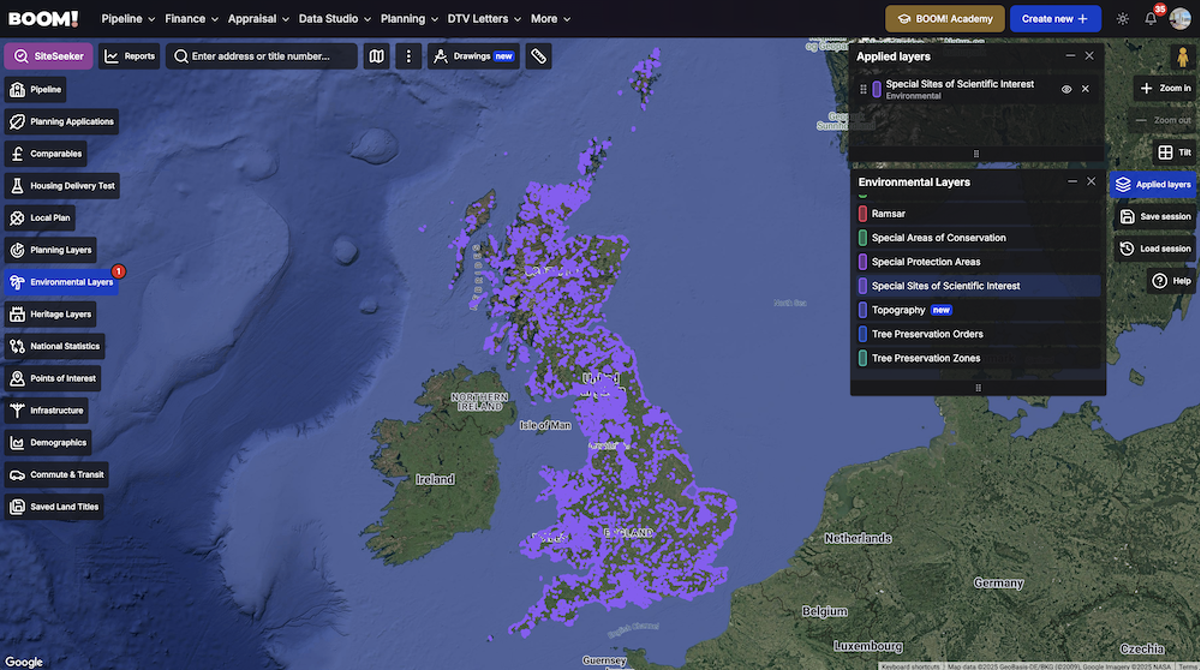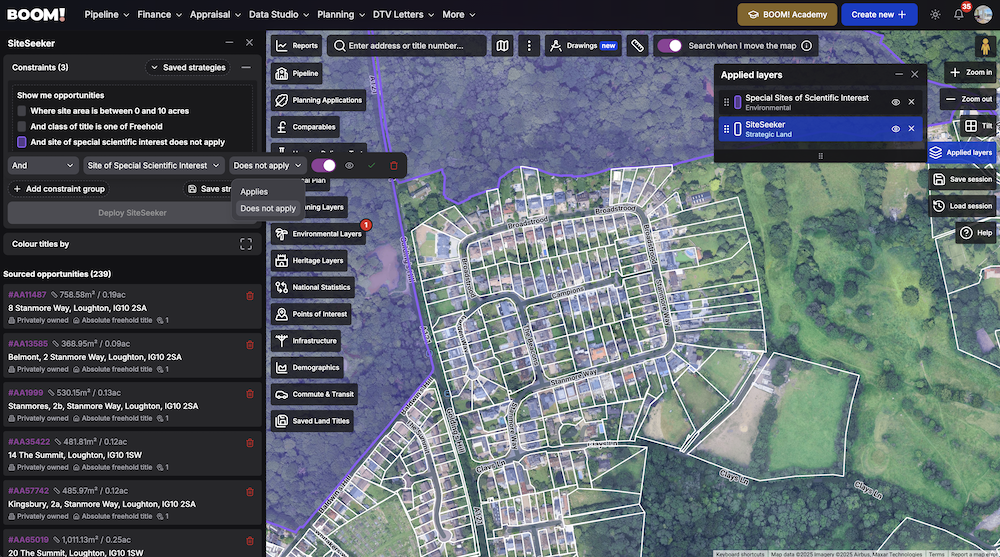Sites of Special Scientific Interest (SSSIs) 101: Hidden Opportunities and Pitfalls for UK Developers







Imagine spotting a “bargain” plot of land only to discover it’s a protected wildlife haven. One misstep and your dream project could be halted by law. Sites of Special Scientific Interest (SSSIs) are exactly that scenario – protected areas where nature comes first. They cover over 8% of England’s land (4,100+ sites) and about 12% of Wales. In other words, thousands of places across the UK are SSSIs, and if you’re sourcing land, you’re bound to encounter one. Ignore SSSIs at your peril: doing the wrong thing on these sites can cost you dearly – in time, money, and even legal trouble. But what if you could turn this hurdle into an opportunity? Let’s break down why SSSIs matter for developers, the hidden opportunities they offer, and how to stay compliant while seizing an edge.
Why SSSIs Can Make or Break Your Development
What exactly is an SSSI? Think of it as a “no-go” zone for reckless development – land or water designated for special wildlife, plants, or geology. It could be an ancient woodland, a marsh teeming with rare birds, or a unique rock formation. These sites are protected by law (Wildlife and Countryside Act 1981) and overseen by agencies like Natural England. In plain terms, if your site is within or next to an SSSI, you face extra scrutiny and rules. The UK’s planning policy says development “should not have an adverse effect” on an SSSI. Build something that harms that special habitat, and permission will usually be refused. Even if you’re just adjacent to an SSSI, local authorities will consult Natural England and demand proof that your project won’t damage the site.
Why should you care? Because the cost of getting it wrong is huge. If you bulldoze ahead and damage an SSSI without proper approval, you could face fines up to £20,000 – or even unlimited fines for serious cases. It’s not just about money: time is on the line too. Your planning application can stall for months while ecologists and officials pick it apart. In Wales, for example, any major plan near an SSSI can even be “called in” for review by ministers, adding long delays. Bottom line: a single protected newt or wildflower patch can derail your schedule and budget if you’re unprepared. The urgency is real – due diligence now can save you a nightmare later.
Hidden Opportunities In and Around SSSIs
It’s not all doom and gloom. Surprisingly, an SSSI could hide a golden opportunity for savvy land sourcers. How? Lower competition and lower land prices. Many developers get cold feet when they see a protected designation, so SSSI-tagged land often flies under the radar. In fact, studies show SSSI status can reduce land value if it restricts what you can dodata.parliament.uk. That sounds bad – but for you, it means motivated sellers and bargain prices on sites others dismiss as “undevelopable.” If you do your homework and find a way to build sensitively, you can snag a site and add value where others saw a dead end.
Leverage nature as a feature, not a bug. An SSSI doesn’t always mean “hands off everything.” Each site’s notification comes with a list of what you can’t do and hints at what you can. For example, you might not be allowed to clear an ancient hedge, but you could design your project around it – giving future homeowners a beautiful wild green space as a premium amenity. Developments that coexist with nature can command higher desirability (who wouldn’t want to live next to a wildlife sanctuary?). Some forward-thinking developers have even turned SSSI proximity into a selling point, marketing their homes as “nestled by a protected nature reserve.”
There are also cases where owning or managing SSSI land can unlock financial incentives. Conservation grants and agri-environment schemes often pay landowners to protect or enhance SSSI habitats, offsetting some of your costsdata.parliament.uk. And with new biodiversity net gain rules in England requiring developers to improve nature by 10%, being near an SSSI could inspire creative ways to meet those targets. Instead of fighting the designation, you collaborate with it – maybe by creating new habitat on-site or funding improvements to the SSSI. This isn’t just feel-good environmentalism; it’s strategy. You’re turning a potential roadblock into a way to strengthen your planning case (showing officials you’re enhancing biodiversity) and potentially speed up approval.
How to Stay Compliant and Come Out on Top

To succeed with sites in or around SSSIs, you need a smart game plan. Here’s your compliance checklist for turning SSSI challenges into wins:
Do Your Homework Early: Before you buy or design, check BOOM! to se if the land is an SSSI or in an Impact Risk Zone. If it is, study the site’s rules – know exactly what’s protected there (species, habitats) and what activities are off-limits. Knowledge is power; surprises are your enemy.
Consult the Experts: Reach out to Natural England and an ecologist right away. Don’t fear them – partner with them. Let them know your intentions and ask for guidance. By law, you’ll likely need their sign-off or advice, so bring them in as allies, not adversaries. An early chat can reveal what design tweaks would make your project acceptable. (Plus, showing this goodwill can impress the planning officers.)
Design with Nature in Mind: Plan your development to avoid or minimise harm. Leave buffer zones around sensitive areas, adjust layouts to protect that rare pond, schedule construction for seasons that are less disruptive to wildlife. If you can prove your scheme won’t “adversely affect” the SSSI, you’re halfway to approval. This might mean building fewer units or altering access roads – but it beats a flat refusal.
Offer Mitigation or Offsetting: If some impact is unavoidable, come prepared with a biodiversity offset plan. UK authorities often require developers to compensate for any damage to an SSSI by improving habitat elsewhere. This could mean funding the restoration of another site or creating new wetlands/woods on your own land. It’s an added cost, yes – but it can tip the scales in your favour by proving the overall benefit outweighs the harm.
Get Everything in Writing: Document your consultations, environmental surveys, and mitigation commitments. Show the planners that you’ve left no stone unturned in protecting the SSSI. This builds trust and a paper trail of compliance. It also protects you if questions arise later.
The payoff? By following these steps, you not only stay on the right side of the law, you also position yourself as a responsible developer. That reputation can go a long way – communities and councils are more welcoming to projects that respect local environment rather than steamroll it.
In conclusion, Sites of Special Scientific Interest can seem like minefields to a new property developer. They certainly are serious business – move too fast or blind, and you could face refusals, fines, or a PR disaster. But now you know what most newcomers don’t. You’ve learned that while SSSIs impose strict limits, they also hide opportunities for those willing to innovate and adapt. Instead of running away, you can approach these sites with confidence (and caution), armed with facts and expert support. In a competitive land sourcing game, this knowledge gives you an edge – the ability to spot diamonds in the rough (or rather, in the wild). So the next time you see a plot flagged as a protected site, you won’t panic. You’ll lean in with curiosity, do the legwork, and possibly turn that “protected” piece of land into your flagship development – one that balances profit and nature. That’s not just good business; that’s leaving a legacy any developer can be proud of.
Remember: the only thing more costly than acting with caution around an SSSI is wishing you had. Use this insider knowledge to outsmart the competition and build projects that thrive in harmony with Britain’s most special places. The result? You win, and nature wins too.
To find out how BOOM! can help book in a call with our team.